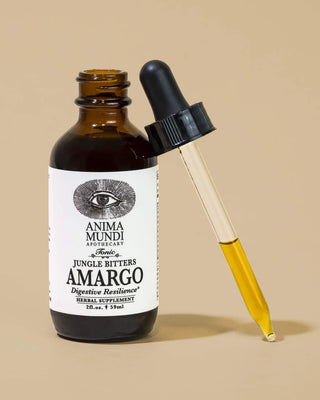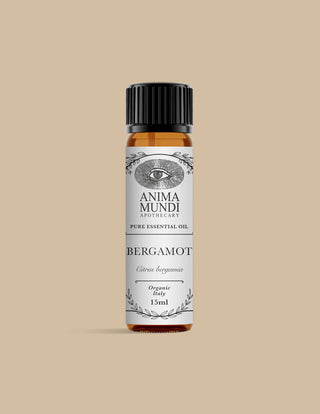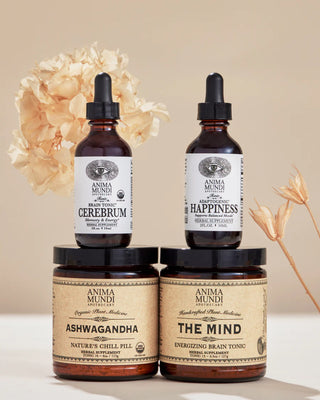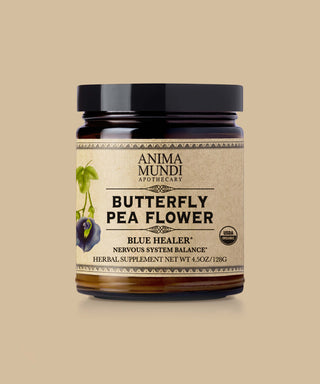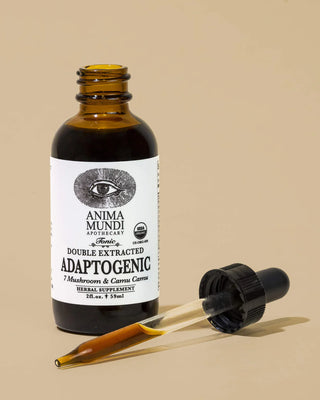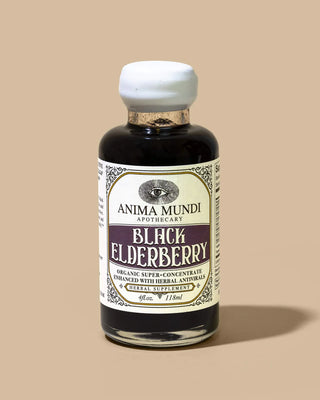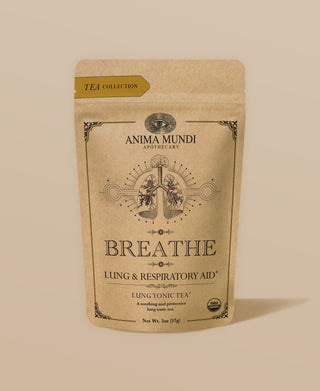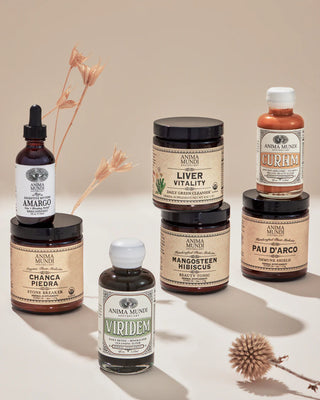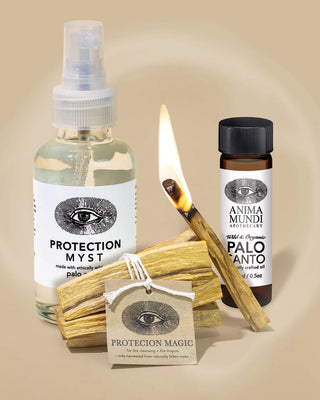All product imagery and descriptions have been graciously provided by Anima Mundi and are displayed for demonstration purposes only. You can buy their products on their online store.

A true state of wellness is not merely dependent on the condition or mind-set a person currently inhabits. Our level of wellness is finely interwoven with the intimate relationship we have with our community, our environment, and ourselves. The multifaceted universe of health and healing is cyclical, a living organism in constant metamorphosis. Healing echoes the logic of quantum physics, suggesting that we exist in a relative, process-oriented ecosystem in which there is no “objectivity” to the world we’re experiencing. The components essential to healing disease cannot be resolved simply by measuring the illness in itself; rather, this healing ecosystem is active, with its own unique interactions and relationships. It is through this process that the healer balances the equation of physical, mental, and social well-being.
In Eastern healing traditions, human beings are perceived as microcosms of the universe, composed of the same forces controlling the cosmos. In Daoism, for example, humans are imagined as part of the unbroken whole, called Dao—a singular relational continuum expressing itself within and without. This thinking predates the separation of the mind from the body. It was the Western mind that created the idea that human beings are independent living systems, unbound by basic natural needs. We escaped from our dependency and attachment to the natural world, pursuing egotistic principles of invulnerability, invincibility, and immortality. The long-term survival of our species is threatened by the unrestrained lust for short-term gain, deceitful beliefs about accomplishment, and false assumptions about our civilization’s autonomy from nature.
Modern-day human beings have contaminated their own nests, a clear sign of disease and future troubles, especially considering the consequences of our actions on the wider animal kingdom. Today, many of us seek to reclaim the sense of connectedness that existed universally in ancient cultures, when human fate was wholly entwined with nature. In the ecological understanding of these cosmologies, all things were inextricably bound together. The world was seen as a symbiotic entity in which all living organisms interacted with and supported one another, from the innermost cellular level to the outermost cosmological level.
The call for plant medicine in today’s culture is a symbol of humanity returning to its source. A profound rebirth is in process, and the role of the plant kingdom is increasing in significance. An essential bridge is being rebuilt between humans and nature, allowing us to access the realm of our origin and the land of the luminous. Plant medicines aren’t just here to provide us nourishment, shelter, and protection from pathologies—they’re here for a much larger purpose, and that is to bring us back to the original consciousness that prevailed on earth for millennia. Herbalism is the medicine of belonging, a gateway through which we keep alive a very sacred aspect to our source.

 Adaptogens are remarkable botanical treasures that help the body restore balance and adapt to stress. They work by increasing the body’s resistance to multiple stressors, including physical, emotional, chemical, and environmental. They also shield against acute and chronic stress. Their normalizing effects on the body, particularly regarding the endocrine and immune systems, are what make them unique, though each and every adaptogen operates differently for each individual person. By working nonspecifically, they alter base operations within the organism, regaining homeostasis (a state of equilibrium) through their regenerative properties and helping to harmonize the body, mind, and spirit.
Adaptogens are remarkable botanical treasures that help the body restore balance and adapt to stress. They work by increasing the body’s resistance to multiple stressors, including physical, emotional, chemical, and environmental. They also shield against acute and chronic stress. Their normalizing effects on the body, particularly regarding the endocrine and immune systems, are what make them unique, though each and every adaptogen operates differently for each individual person. By working nonspecifically, they alter base operations within the organism, regaining homeostasis (a state of equilibrium) through their regenerative properties and helping to harmonize the body, mind, and spirit.Adaptogens Have Existed for Millennia
Although the concept has only existed since the late 1940s, these wonderful plants have been revered for centuries. Nearly every culture in the world has used rejuvenating and restorative plants with properties similar to those of modern-day adaptogens. In Daoism, for example, many of the herbs that achieve the same results as adaptogens are referred to as “tonic herbs.” In Chinese herbal medicine, they’re called “qi tonics.” In Ayurveda, a system of medicine developed in India, they’re known as “rasayanas.” And in Western herbal medicine, some of the herbs that fall under “nutritive tonics” and “trophorestoratives”, essentially paralleling adaptogenic herbs. In rainforest herbalism, herbs similar to adaptogens tend to be called “para-toda,” meaning “heal-all.” Modern clinical research has slowly proven that much of the lore around these herbs is indeed true. As far as scientific and clinical studies are concerned, adaptogenic herbs have received the most attention. The wide range of healing benefits that they offer covers almost every area of the body.

Organs Involved in the Stress Response
Adaptogens use their balancing powers to catalyze changes in the body, particularly in the neuroendocrine and immune systems. The endocrine system and the nervous system are so closely related that they are often lumped into a single system: the neuroendocrine system. This system deals with chemical communication in the body via hormones, which work in conjunction with the nervous system. The goal of the nervous system is to bring homeostasis to all internal responses, which helps keep the body healthy and protected. Within the endocrine system is the famed HPA axis, a complex set of interactions between the hypothalamus, pituitary, and adrenal glands. The hypothalamus (H) is the command center of the brain, often called our “god center.” This area of the brain communicates with the rest of the body through the autonomic nervous system and through influxes of hormones. It oversees and assesses everything going on in the body, then informs its “personal assistant,” the pituitary (P) gland, what to do. The personal assistant informs the “general managers” (the target organs), which then enlist the “workers” (particular biochemical processes) in the relevant tissues or organs of the body. The enlisted or activated tissues include the visceral organs—heart, lungs, intestines, kidneys, liver, and pancreas—as well as many lesser-known parts of the body such as the gallbladder, spleen, blood vessels, and skeletal muscles.
Sympathoadrenal System
The connection between the hypothalamus, the adrenal medulla, and the sympathetic nervous system is referred to as the sympathoadrenal system (SAS).
Stress Hormones
This section describes the different hormones secreted within the endocrine system and how they are triggered by the stress response. Cortisol, one of the better-known stress hormones and the primary hormone released from the adrenal glands, is often called the “stress hormone.” When cortisol is secreted, it causes a breakdown of muscle protein, leading to the release of amino acids into the bloodstream. Amino acids are processed by the liver to synthesize glucose. This process raises blood sugar levels in the brain, which gives us energy. At the same time, the other tissues in the body decrease their use of glucose. Cortisol also leads to the release of fatty acids for use by the muscles. The processes directing and replenishing energy prepare the body to manage stress and ensure that the brain receives adequate energy sources. Another important purpose of cortisol in the body is the regulation of blood pressure and cardiovascular functions. It also assists the immune system in responding to infection and inflammation. Cortisol levels are at their highest in the morning.

When the Natural Stress Response Goes Haywire
The body’s stress-response system is usually self-limiting. Once a perceived threat has passed, hormone levels return to normal. As adrenaline and cortisol levels drop, your heart rate and blood pressure return to baseline levels, and other systems resume their regular activities. But when stressors are always present and you constantly feel under attack, that fight-or-flight reaction stays turned on.
The Results of Unmanaged Stress
Overadaptation to stress and disruption of the HPA axis’s flow are at the core of many health issues. For example, when the HPA axis is strong, your body is usually able to handle even high levels of stress. A strong HPA axis is also helpful for pregnant women, women who have just given birth, and women in menopause. Over time, the repeated activation of stress hormones, aka the fight-or-flight response, can take a serious toll on the body. Research suggests that chronic stress contributes to high blood pressure, promotes the formation of artery-clogging deposits, and causes brain changes that may contribute to anxiety, depression, and addiction. Preliminary research suggests that chronic stress may also contribute to obesity, both directly (causing people to eat more) and indirectly (decreasing sleep and exercise).
Chronic stress and the oversecretion of cortisol and other stress hormones can disrupt almost all of the body’s processes. Overexposure to cortisol can cause numerous health problems. One well-known problem is adrenal fatigue. Adrenals produce and control the release of cortisol. When the adrenals chronically secrete cortisol and other stress hormones, your adrenals stop producing cortisol, leading to adrenal fatigue. Adrenal fatigue is a term often used by health professionals to describe the phenomenon of the adrenal glands running on empty and the resulting mental and physical state of those experiencing it. During stressful periods, our glands release high levels of cortisol, which is the most important hormone we have to help the body manage stress. Think of cortisol as our own built-in alarm system, alerting us when the body is in danger. It also works with certain parts of the brain to control mood, motivation, and fear. If too much cortisol is secreted, many bodily processes begin to underperform, potentially resulting in illness.

Stressors can come from many different angles, and can manifest at any time. It often comes and goes, and many different types of stressors can easily affect us without our noticing. Modern-day culture is experiencing unusually high volumes of stress from the environment—perhaps the highest volumes in recorded history. Toxins in our water, air, food, and atmosphere are contributing significantly to higher levels of stress in our bodies and minds. It’s important to remember that a healthy lifestyle, coupled with adaptogenic herbs and a positive mindset, can help us lead fulfilling, balanced lives.
1. Ashwagandha (Withania somnifera)
Tonic, anti-inflammatory, antioxidant, immune amphoteric, antitumor, nervine, antispasmodic, mild astringent, and diuretic.
Due to ashwagandha’s noted ability to combat the effects of oxidative stress, it has been used to assist those diagnosed with sleep disorders or sleep problems. Some animal- and human-based studies have shown that the herb can also promote nerve growth. On a psychological note, ashwagandha has been successfully used to treat those suffering from obsessive-compulsive disorder, hyperactivity, and attention deficit disorder. Additionally, the herb is considered beneficial to the elderly, providing energy and relieving pain, inflammation, and anxiety.
2. He Shou Wu (Polygonum multiflorum)
Antioxidant, astringent, cholagogue, cholesterol lowering, hepatoprotective, laxative, and neuroprotective.
He shou wu has long been revered as a vital longevity tonic within the Chinese and Daoist pharmacopeia. It has been highly sought after since it was first recorded as one of the best-prepared vitality tonics by Daoist monks. Not only was it prized for its longevity chemistry, it was also regarded as an important “shen” (aka spirit tonic). Its leaves, root tubers, and rhizomes have been used as vitality agents within many formulas. These formulas offer a number of pharmacological benefits, including anti-aging, immunologic, neuroprotective, anticancer, and anti-inflammatory properties. Various scientific research shows that he shou wu improves the immune system, lowers bad cholesterol, reverses hardening of the arteries, improves bowel movement, regulates epinephrine and norepinephrine, regulates blood sugar, and is liver protective and antioxidative.

3. Mucuna (Mucuna pruriens)
Anti-inflammatory, immunostimulant, anti-cancerous, and adaptogenic.
Mucuna’s panacea-like use and folkloric reputation are the reasons behind its being called the “magic velvet bean.” It is commonly used as a brain enhancer and libido and fertility booster because of its L-dopa content. Many indigenous cultures in Central America, South America, and India consider mucuna to be a heal-all, though technically it is not an official adaptogen. It is often treated like an adaptogen because of its broad-spectrum healing abilities, including its anti-aging and antioxidant properties. It is also believed to combat oxidative stress, enhance insulin release, and facilitate the growth of nervous tissue.
One of the infamous constituents within mucuna is L-dopa. L-dopa is a precursor to the neurotransmitter dopamine, norepinephrine (noradrenaline), and epinephrine (adrenaline). The body uses L-dopa to manufacture dopamine. Dopamine has a significant role in the body as it makes it possible for us to transfer information from neuron to neuron, assisting in part of the regulation of our mood (in particular our feel good hormones), motor control, sex drive, immune function, growth hormone levels, growth hormone release, and behavior.
Mood elevator and nootropic mucuna has also shown impressive abilities to fight depression due to its neurological balancing. When it comes to depression, we talk about serotonin and norepinephrine much more often than we do about dopamine. It is now understood that the deficiency of dopamine in specific parts of the brain is what can trigger low moods and depressive symptoms. Low dopamine in the brain’s emotional (mesolimbic) centers can cause the inability to feel pleasure, which is common in depression. Low dopamine in cognitive areas can trigger a lack of motivation, another common symptom of those suffering from depression. In several studies, Mucuna pruriens extract showed significant dopamine-boosting action, improved symptoms of depression in general, as well as significantly lower stress levels.
4. Reishi (Ganoderma lucidum)
Adaptogen (mild), cholesterol lowering, anti-inflammatory, antioxidant, antiviral, heart tonic, hepatoprotective, immunomodulator, and nervine.
Many revered Daoists and monks believe that reishi is a powerful “shen tonic,” which translates loosely to an herb that “nourishes the spirit.” Although this claim cannot be verified by science directly, reishi has been used as a “spirit tonic” as it’s known to profoundly relax the nervous system, calm the mind, and induce a state of relaxed focus. This last benefit has long been valued by spiritual seekers, meditators, and those looking to relieve the stresses of daily life.
Reishi is 10 to 20 percent protein. Animal studies performed using extracts of its protein showed lower blood pressures in hypertensive rats, with effects lasting up to eight hours. Other studies have shown that reishi can help reduce both cholesterol and insulin resistance. Reishi has been found to protect nerve cells against damage, degeneration, and impairment of function. It significantly decreases fatigue, anxiety, and depression, and improves one’s outlook and sense of well-being.
5. Schisandra (Schisandra chinensis)
Adaptogen, antioxidant, anti-inflammatory, immune tonic, astringent, hepatoprotective, nervine, and expectorant.
Schisandra’s adaptogenic properties help maintain an internal balance in the body and reduce biochemical indicators of stress on the body. These adaptogenic properties help the body calm down and cope with mental and physical stress. Its adaptogenic nature regulates many organ systems, including the central and sympathetic nervous system, the endocrine system, the immune systems, the respiratory system, the cardiovascular system, and the gastrointestinal tract. The berries and/or seeds of schisandra are thought to enhance the endocrine system and nonspecific immune system function. Nonspecific immune cells are the cells in the immune system most affected by stress, and they tend to be inhibited by chronic anxiety, anger, depression, and fear. Studies have found that schisandra has a normalizing effect on blood pressure, lowering elevated blood pressure or raising low blood pressure.

5. Suma (Pfaffia paniculata)
Anti-inflammatory, immunostimulant, anti-cancerous, and adaptogenic.
Suma, a plant native to the Amazon basin, is known as “para toda,” meaning “for all things,” and also as “Brazilian ginseng.” The indigenous peoples of the Amazon region who named it “para toda” have used its root for generations, and it is used in a variety of ways, including as a general tonic, an energy rejuvenator, and a sexual tonic. It is also used as a general cure-all for many types of illnesses. For at least 300 years, suma has been used as an aphrodisiac, a calming agent, and an ulcer treatment. Several indigenous Brazilian tribes still consider it a key herbal remedy and food.
Suma is not yet recognized as an official adaptogen due to a lack of research, though research has shown that the root can increase the body’s resistance against many physical, chemical, and biochemical threats, and can serve as an anti-stress agent. In North American herbalism, suma root is applied as a nutritive and regenerative tonic and is believed to help regulate many of the body’s systems. As an immunostimulant, suma can help treat exhaustion and chronic fatigue, impotence, arthritis, anemia, diabetes, cancer, tumors, mononucleosis, high blood pressure, PMS, menopausal symptoms, hormonal disorders, and many types of stress.
Modern research shows suma to greatly improve resistance to stress and disease, increase stamina and endurance, and assist in recovery after illness or injury. Suma is also known as “female ginseng” as it’s known to be a hormone balancer; it also aids in the treatment of menstrual and menopausal symptoms, vaginal atrophy, and infertility, and increases sexual function (in both men and women), while minimizing the effects of birth control medications.

